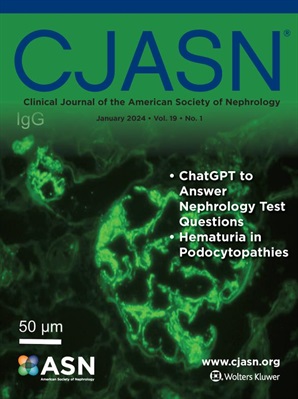胱抑素 C 与急性肾损伤需要持续肾脏替代疗法患者的肾功能恢复。
IF 8.5
1区 医学
Q1 UROLOGY & NEPHROLOGY
Clinical Journal of the American Society of Nephrology
Pub Date : 2024-11-01
Epub Date: 2024-08-21
DOI:10.2215/CJN.0000000000000531
引用次数: 0
摘要
背景:血浆胱抑素 C 是估测肾功能的可靠指标;然而,在接受持续肾脏替代疗法(CKRT)的患者中,这一指标是否仍然有效尚不得而知。在此,我们检验了一个假设,即在 CKRT 的前三天,较低的血浆胱抑素 C 浓度可预测肾功能的恢复情况:我们对一项由 126 名患者参与的单中心 CKRT 研究中的 72 名患者进行了回顾性观察研究。我们研究了两组事先定义的无晚期 CKD、需要接受 CKRT(AKI-CKRT)治疗的急性肾损伤患者:1)肾功能早期恢复,即在开始接受 CKRT 治疗后七天内脱离 KRT;2)肾功能延迟恢复,即接受 KRT 治疗时间超过 21 天或在接受 KRT 治疗期间死亡。随后的分析包括晚期慢性肾功能衰竭和肾功能中度恢复(8 至 21 天内恢复)的患者。然后,对开始接受 CKRT 之前以及 CKRT 第 1、2 和 3 天收集的储存血浆、尿液和透析出水进行胱抑素 C 检测:结果:肾功能恢复较早的患者在 CKRT 第 1 天(1.79 vs. 2.39mg/L)、第 2 天(1.91 vs. 2.38mg/L)和第 3 天(2.04 vs. 2.67mg/L)的血浆胱抑素 C 明显低于肾功能恢复延迟的患者。肾功能恢复较早和较晚的患者胱抑素 C 的筛分系数和 CKRT 清除率相似。CKRT 第 1-3 天的最低血浆胱抑素 C 浓度可预测早期肾功能恢复,其接收器工作曲线下面积为 0.77(P = 0.002),血浆胱抑素 C 的正似然比为 5.60:CKRT 头三天血浆胱抑素 C 浓度较低与肾功能早期恢复有关。本文章由计算机程序翻译,如有差异,请以英文原文为准。
Cystatin C and Kidney Function Recovery in Patients Requiring Continuous KRT for Acute Kidney Injury.
求助全文
通过发布文献求助,成功后即可免费获取论文全文。
去求助
来源期刊
CiteScore
12.20
自引率
3.10%
发文量
514
审稿时长
3-6 weeks
期刊介绍:
The Clinical Journal of the American Society of Nephrology strives to establish itself as the foremost authority in communicating and influencing advances in clinical nephrology by (1) swiftly and effectively disseminating pivotal developments in clinical and translational research in nephrology, encompassing innovations in research methods and care delivery; (2) providing context for these advances in relation to future research directions and patient care; and (3) becoming a key voice on issues with potential implications for the clinical practice of nephrology, particularly within the United States. Original manuscript topics cover a range of areas, including Acid/Base and Electrolyte Disorders, Acute Kidney Injury and ICU Nephrology, Chronic Kidney Disease, Clinical Nephrology, Cystic Kidney Disease, Diabetes and the Kidney, Genetics, Geriatric and Palliative Nephrology, Glomerular and Tubulointerstitial Diseases, Hypertension, Maintenance Dialysis, Mineral Metabolism, Nephrolithiasis, and Transplantation.

 求助内容:
求助内容: 应助结果提醒方式:
应助结果提醒方式:


